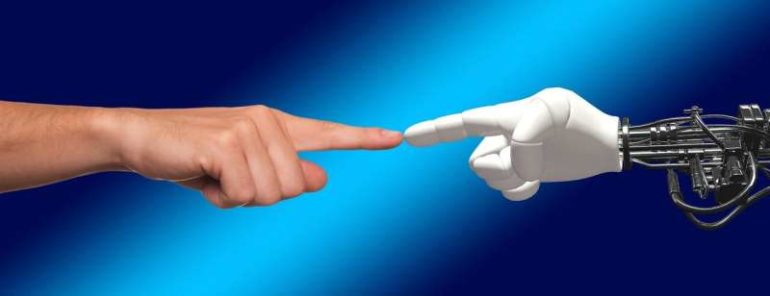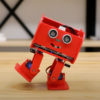Not long after the 1918 Spanish flu pandemic, Czech writer Karel Čapek first introduced the term “robot” to describe artificial people in his 1921 sci-fi play R.U.R. While we have not yet created the highly intelligent humanoid robots imagined by Čapek, the robots most commonly used today are complex systems that work alongside humans, assisting with an ever-expanding set of tasks.
In a piece in Nature Machine Intelligence, Johns Hopkins researchers discuss how the coronavirus pandemic has driven unexpected innovations in automation, while at the same time revealing bottlenecks to deploying robotic systems in health care settings. They contend that advances in human-robot interaction—such as improving robots’ capabilities to feel, touch, and decide—will determine if the robots of tomorrow will help hospitals stay ahead of the next pandemic.
In the commentary, the team identifies three ways robots have greatly enhanced patient care and provider safety during COVID-19: minimizing contact between infected patients and care providers, reducing the need for PPE, and giving providers more time to focus on critical tasks. They look ahead to how technologies can be leveraged to develop adaptable and reliable robots for future infectious disease crises.
The Hub reached out to commentary authors Axel Krieger and Russell Taylor of the Whiting School of Engineering, and Brian Garibaldi, director of the Johns Hopkins Biocontainment Unit at Johns Hopkins Medicine, for insights on the future of robots during infectious disease outbreaks.
What has the health care robotics community learned during this crisis?
Taylor: You go into a pandemic with the robots you have, not the robots you wish you had. We can’t build a fleet of robots for an emergency and put them in a warehouse. Not only is that not economically viable, but by the time you need them, they could be obsolete. One thing we recognized is that we need to build core capabilities into deployed systems that can be easily adapted for the challenges of the moment.
We already had robots that delivered meals or could take a patient’s temperature. Now we are talking about much more sophisticated systems—that can do serious cleaning, that can perform nursing tasks, that can do many things beyond just delivering supplies—and that presents some interesting engineering challenges.
A big issue has been deployability and how quickly a non-expert user can customize a robot. For example, our ICU ventilator robot was designed for one kind of ventilator that pushes buttons. But some ventilators have knobs, so we need to be able to add a modality so that the robot can also manipulate knobs. Say you want one robot that can service multiple ventilators; then you’d need a mobile robot with an arm attachment, and that robot could also do plenty of other useful jobs on the hospital floor.
Future robots will play a more significant role in clinical care for infectious disease, but there are still barriers to have robotic tools ready for when the next pandemic hits. Where should engineers concentrate their research efforts to ensure we are prepared?
Krieger: The pandemic has shown some of the current limitations of robotic systems to robustly work and adapt in difficult, changing environments at large scales. Robots in busy hospitals need to be able to manage unexpected events and uncertainty. Research needs to focus on advancing the autonomy and learning strategies for health care robots, so they can perform tasks with only limited supervision. The most realistic approach for health care robots in the near future is shared autonomy, which combines the knowledge of medical experts with the capabilities of robots.
Where are biggest opportunities for robots to help frontline health care workers? Which tasks will be most beneficial?
Garibaldi: A human provider needs to put on fresh PPE every time they enter the room where an infectious patient is being treated. Robots don’t need to wear PPE, so that frees up valuable supplies and time for human providers. The more robots can do, the more it allows human providers to devote their attention to other aspects of care.
I think a big area that engineers should focus on is enhancing the ability of robots to perform fine motor tasks, so they can perform direct patient care tasks such as placing an IV, intubating the trachea, or inserting central lines. Other potential tasks could include basic room cleaning, phlebotomy, and ventilator and monitor management and manipulation.
What role should care providers and patients play in the design of these robotic systems to ensure they are effective and safe?
Garibaldi: Care providers and patients need to be comfortable both with the functionality of robotic systems as well as the actual human-robot interface. There are certain tasks that patients might prefer to be performed by a human clinician. In addition to task selection, patients and caregivers can provide important feedback about the materials used in robotic construction—particularly in components that directly touch a human patient—as well as overall design.
Taylor: They need to be involved in every step of the process. Engineers need feedback on how these systems really work in the wild. We also want to understand their reactions to the systems, especially if a caregiver says, “I’m not sure I can trust a robot to do that.”
What are you researching right now related to this issue?
Taylor: I’m interested in the question of mobile autonomy and situational awareness: how can a computer develop enough information about the environment so that it can do the task it is supposed to do, and how can it relate its general motion and sensing capabilities to that specific task? If I tell a robot to clean a room, the robot needs to be able to understand what is in the room and what needs to be cleaned, and that changes from day to day and room to room. In the Laboratory for Computational Sensing and Robotics, we have teams investigating how augmented reality can enhance human-robot collaboration. Many are working in the context of surgical robots, but there is plenty of overlap with clinical care applications.
Krieger: Our team is working on improvements for our ICU robot to provide higher accuracy and higher fidelity operation of ventilators. We are also investigating the use of robots in performing lung ultrasound imaging using 3D cameras and force sensors. Lastly, we are working on other autonomous surgical robotic procedures, such as suturing and tumor resections.
The current pandemic highlights how remote healthcare robots could be beneficial in the future
More information:
Hao Su et al. Physical human–robot interaction for clinical care in infectious environments, Nature Machine Intelligence (2021). DOI: 10.1038/s42256-021-00324-z
Provided by
Johns Hopkins University
Citation:
Ready for duty: Healthcare robots get good prognosis for next pandemic (2021, March 30)
retrieved 30 March 2021
from https://techxplore.com/news/2021-03-ready-duty-healthcare-robots-good.html
This document is subject to copyright. Apart from any fair dealing for the purpose of private study or research, no
part may be reproduced without the written permission. The content is provided for information purposes only.



